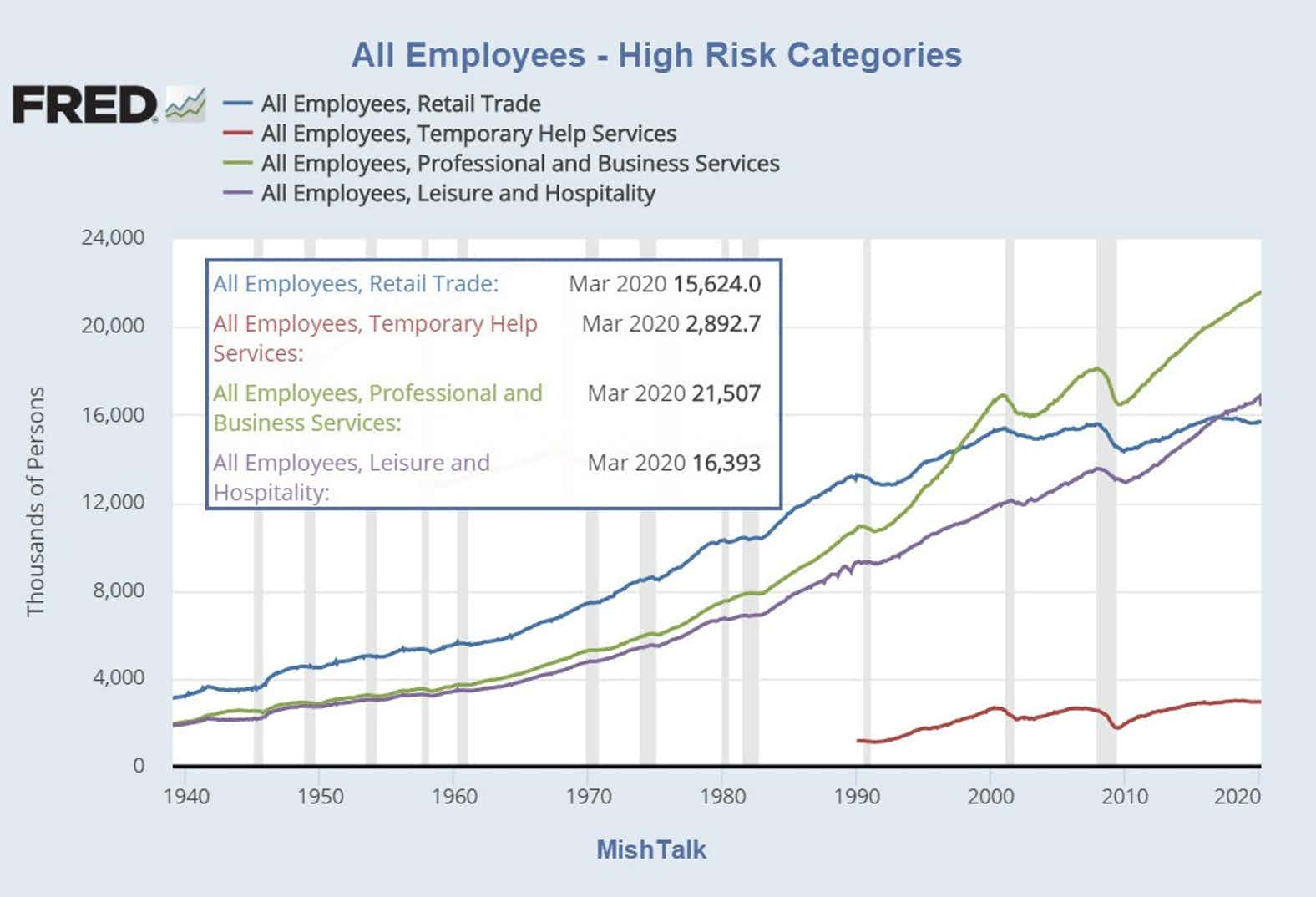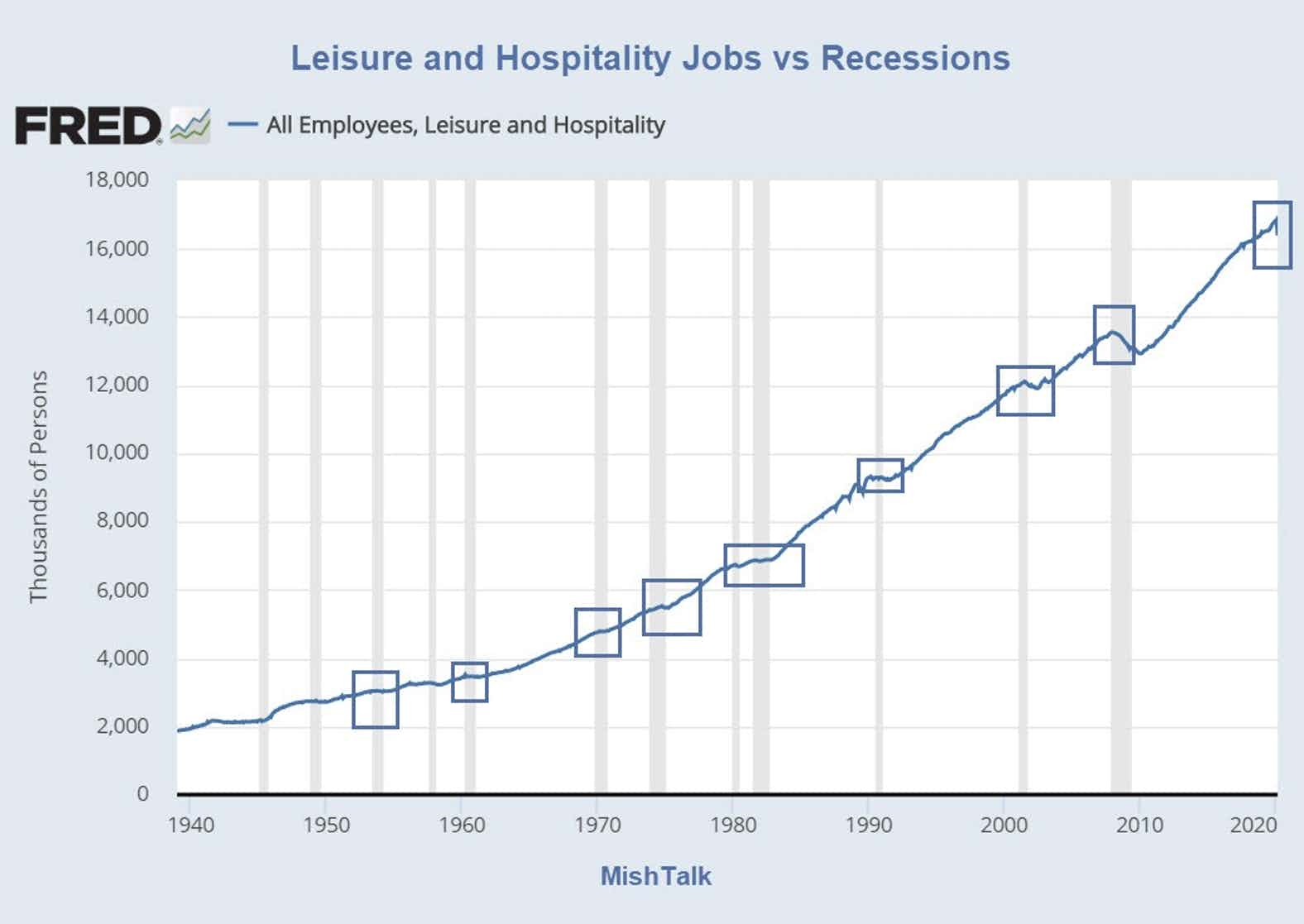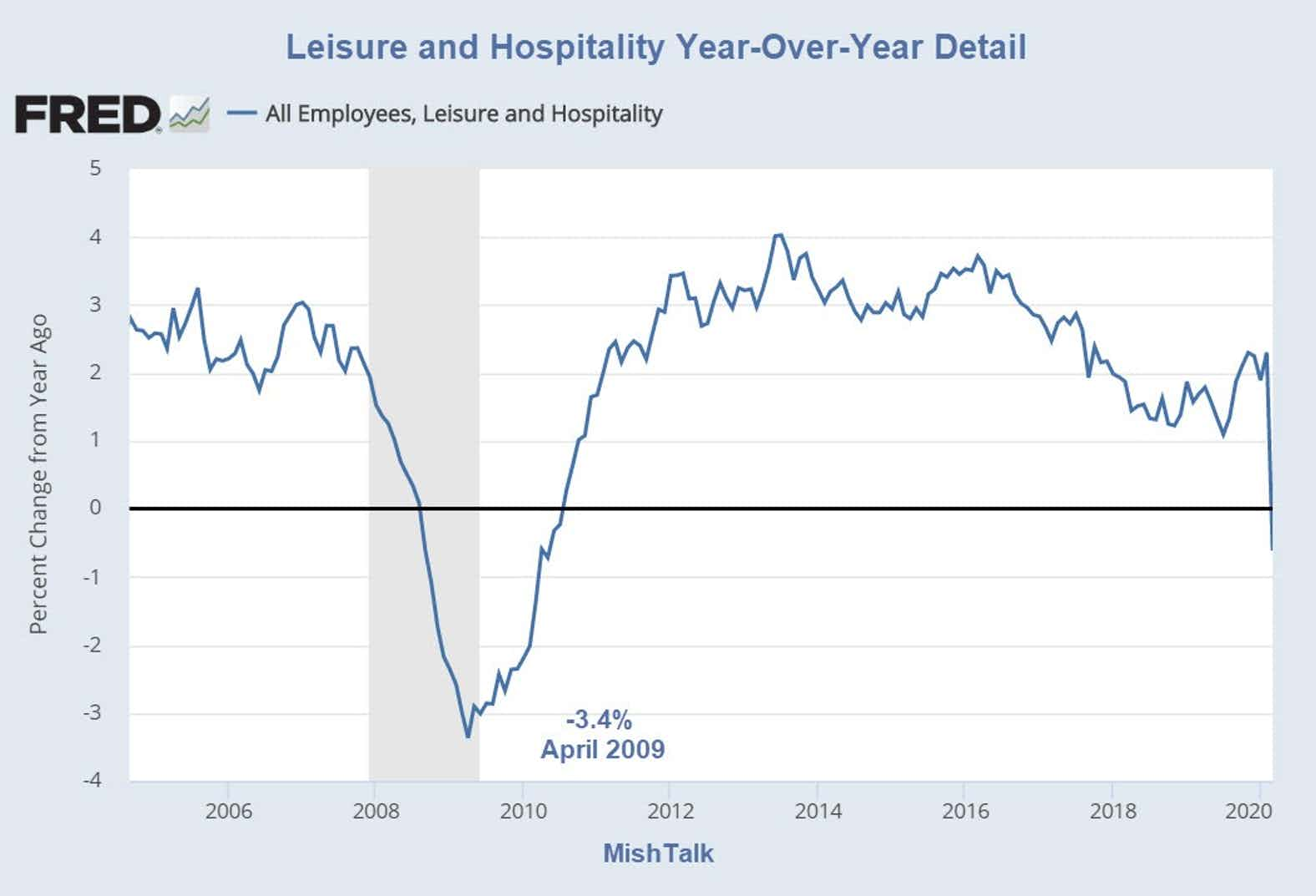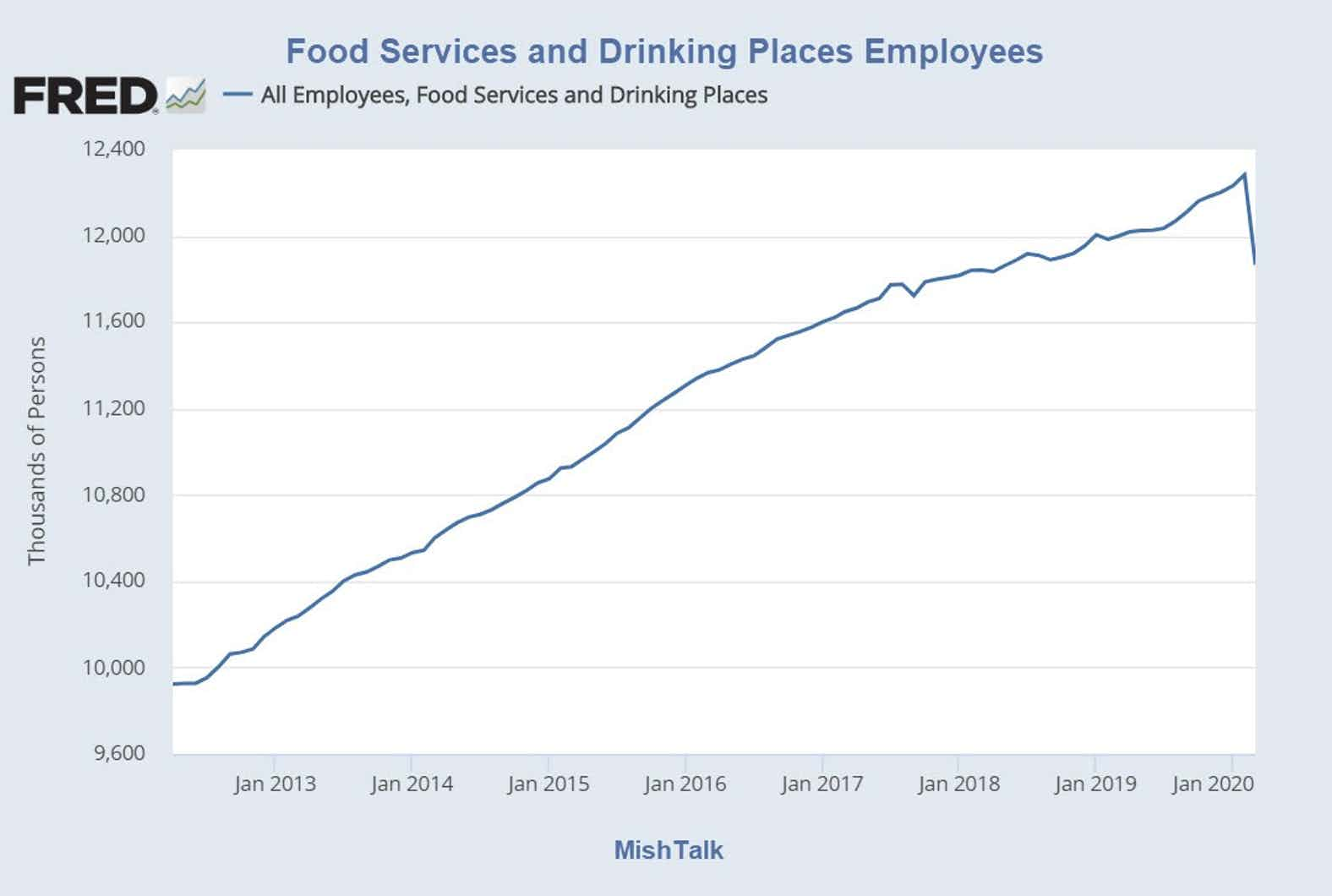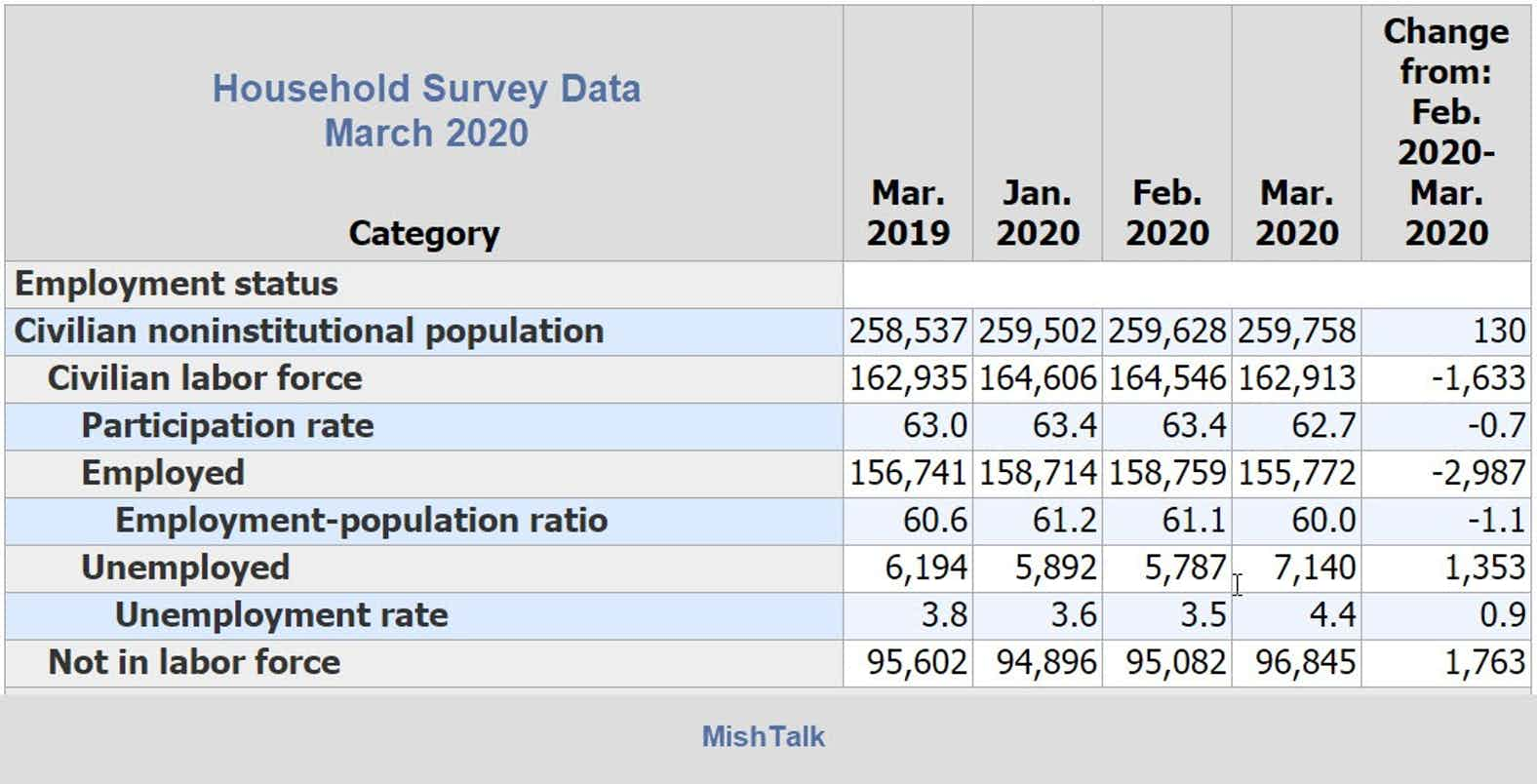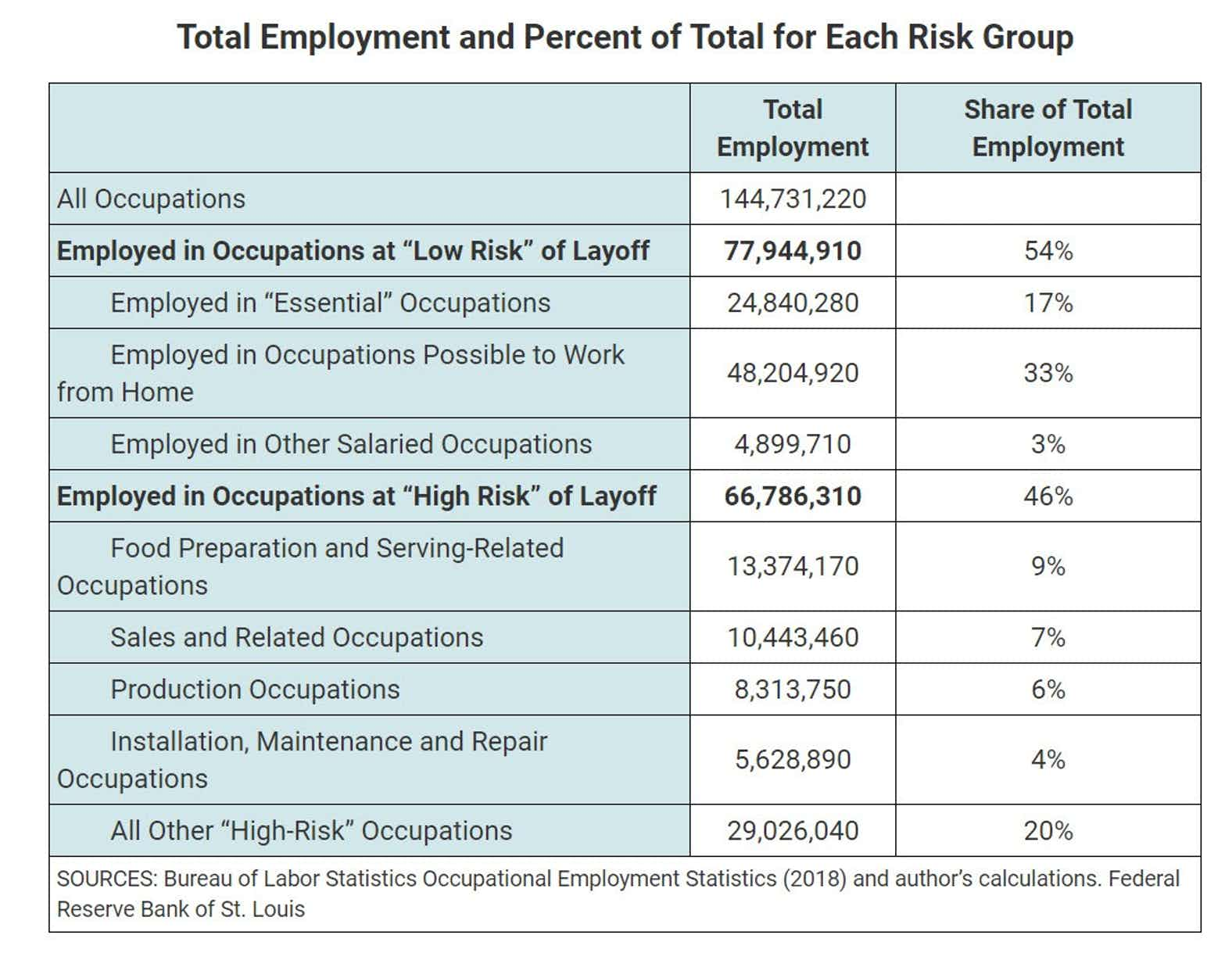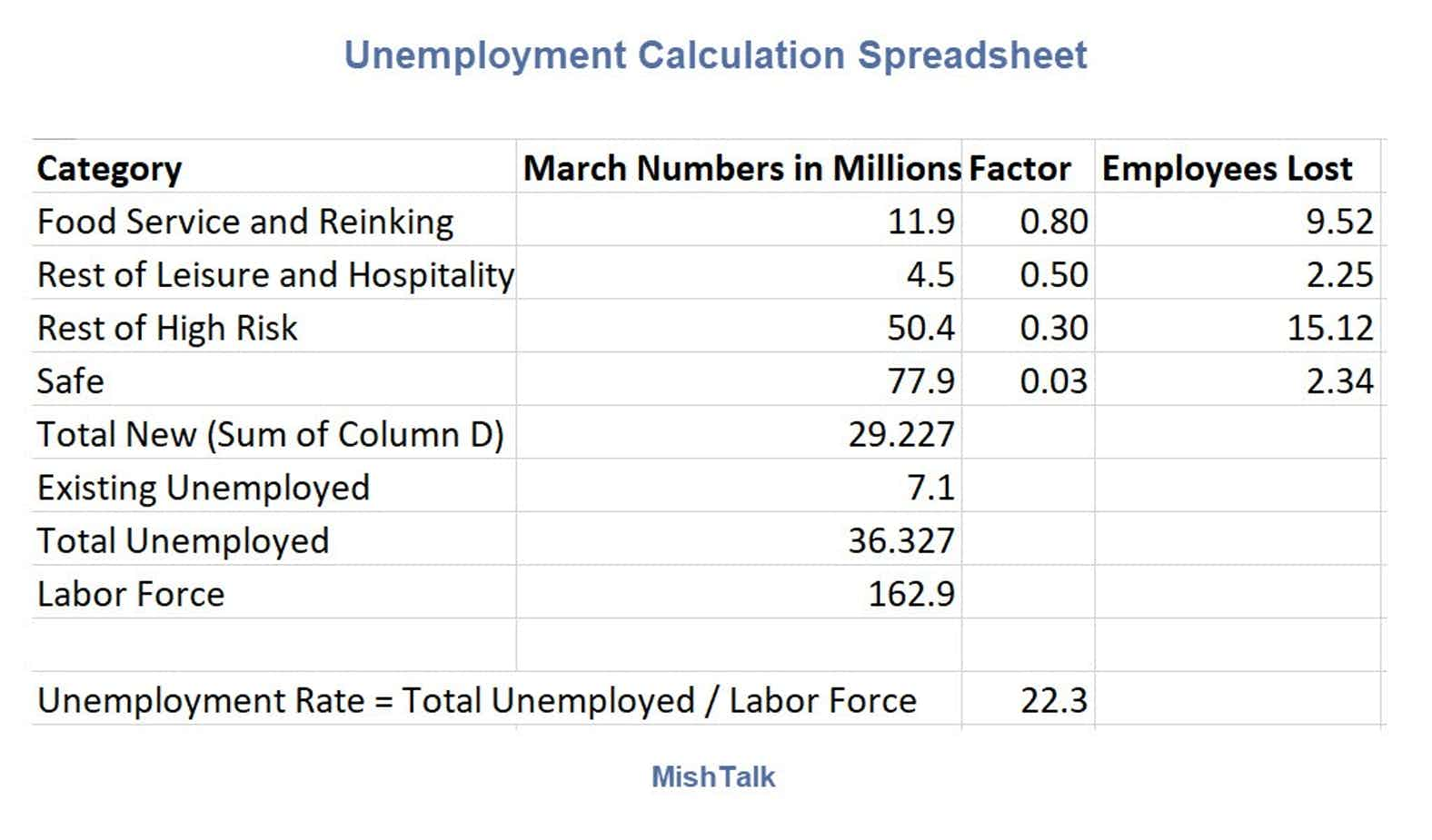Leisure and hospitality jobs once again provide an accurate recession signal.
Leisure and Hospitality Jobs vs Recessions
Leisure and Hospitality Jobs will be the hardest hit in this recession once again so let's start there.
Leisure and Hospitality Percent Change From Year Ago Detail
In February, there were 16.8 million Leisure and Hospitality (L&H) workers.
If only half of them lose their jobs (and that is very optimistic), that's 8.4 million layoffs just in this category.
The previous worst case was -3.4% in April of 2009.
Food Services and Drinking Places
In February there were 12.3 million employed in the Food Services and Drinking Places category.
Food Services is a subset of L&H.
Assuming 80% layoffs, there will be close to 10 million losses in this subcategory alone.
Crunching the Numbers
Let's grab some numbers from my review of the March jobs report Unemployment Rate Jumps to 4.4% But Worst is Yet to Come.
If we make the assumption that the economy will only shed 10 million workers in L&H and none anywhere else, we can calculate the April unemployment rate as follows.
(7.14 million existing + 10 million new) / 162.91 million labor force = 10.5%.
That is a silly assumption given all that it ignores, yet, there are sub 10% unemployment forecasts.
Hard-Hit Employment Categories
L&H will be the hardest hit category but it will not be the only hard-hit category.
What about all the people working in retail stores and temporary help?
Risk Groups
The above chart is from the St. Louis Fed Article COVID-19: Which Workers Face the Highest Unemployment Risk?
The author did not estimate job losses but he did provide a couple of IFs.
For the unemployment rate to reach 9%, an additional 9 million workers would have to become unemployed, the equivalent of 13% of workers in high-risk occupations.
Alternatively, if 50% of workers in high-risk occupations were to be laid off, the unemployment rate would reach 24%.
Nine percent seems wildly optimistic by my model.
Estimating Job Losses
Food Services and Drinking Places: 9.5 million (80% of 11.9 million)
Leisure and Hospitality: 2.3 million (50% of the rest of L&H excluding Food Service (16.4 - 11.9) * .5 )
Retail Trade: 3.9 million (25% of 15.6 million)
Temporary Help: 1 million (33% of 2.9 million)
Professional and Business Services: 3.2 million (15% of 21.6 million jobs)
Teachers: 1 million (25% of 4 million public school teachers. Union rules vary widely.)
There are 151 million All Employees.
Excluding my breakouts, there were another 151-16.4-15.6-2.9-21.6-4 = 94.5 million employed in March.
If 7.5% of them lose their job, that's another 7 million.
Total Job Losses in Millions = 9.5 +2.3 +3.9 +1 +3.2 + 1 + 7 = 27.9 million.
Let's crunch that.
Estimated Unemployment Rate
(7.14 million current + 27.9 million new) / 162.91 million labor force = 21.5%.
Another way to arrive at a similar number is to assume 11.8 million L&H workers and another X% from the rest of the 46% of high risk workers plus another Y% from the bigger safe worker pool.
Unemployment Rate Spreadsheet
Both approaches yield similar numbers.
There are many ways to top the 20% mark assuming my initial estimate of 11.9 million L&H jobs is in the ballpark.
I used Seasonally Adjusted Numbers.
You can try Unadjusted Numbers but you have to use the unadjusted Labor Force and make other assumptions. Then it would be necessary to seasonally adjust the final result because the reported headline unemployment number is seasonally-adjusted.
Looking for a Range?
Try 16% to 28%. Yes, that's wide. It could take two month to reach.
Feel free to plug in your own assumptions from my starting point.
By monitoring the next three weekly unemployment reports, we can hone in on that number.
Regardless, a new record high unemployment rate is baked in the cake and that does not count those forced to part-time work.
Reference Period
The reference period week for determining the unemployment rates is the week that that contains the 12th of the month. That makes the next reference period April 12-18.
If you work as little as one hour in the reference period week, you are considered employed.
The better the unemployment rate looks in the May report (for April), the more likely hours will be reduced across the board somewhere else.
The U-6 unemployment rate which counts people working part-time who want a full time job can easily top 30%.
Heck, a straight up 30% is not out of the question if you consider dentists, dental assistants, ambulatory services, airlines, boeing, GM, and car-related manufacturing, etc, and I am low on retail and the alleged "safe" group.
How Fast a Recovery?
Eventually, the coronavirus depression will subside. But what will America look like when it does?
The huge fear now is How Do I Pay the Bills?
This is the second crisis in 12 years. These scars will last.
Note that Vehicle Sales Plunge by 5.5 Million Units, Most Since 1987.
With the stock market down and consumer savings wiped out, will car sales quickly recover?
The same question applies to eating out and airline travel. Simply put, a quick return to business as usual is not in the cards.
For a 20-point discussion of what to expect, please see Nothing is Working Now: What's Next for America?
No V-Shaped Recovery
Add it all up and you should quickly arrive at the correct viewpoint: The Covid-19 Recession Will Be Deeper Than the Great Financial Crisis.
Mike "Mish" Shedlock
This material is based upon information that Sitka Pacific Capital Management considers reliable and endeavors to keep current, Sitka Pacific Capital Management does not assure that this material is accurate, current or complete, and it should not be relied upon as such.
Recommended Content
Editors’ Picks

EUR/USD extends gains above 1.0400 ahead of Eurozone inflation data
EUR/USD is extending gains above 1.0400 in the European trading hours on Tuesday. The sustained US Dollar weakness and profit-taking ahead of the Eurozone inflation data underpin the pair. US ISM Services PMI and Job Openings data are also awaited.

GBP/USD rises further toward 1.2600 amid weaker US Dollar
GBP/USD strengthens its bid tone and eyes 1.2600 in Tuesday's European session. The pair's advance is driven by a broadly subdued US Dollar and a mildly positive market mood heading into the US economic data releases.

Gold price bulls seem non-committed amid Fed's hawkish signal
Gold price attracts haven flows amid worries about Trump’s tariff plans. The Fed’s hawkish stance and elevated US bond yields cap the XAU/USD. Traders keenly await FOMC minutes and US NFP releases later this week.

Injective Price Prediction: INJ 3.0 upgrade reduces the token supply
Injective price extends its gains for the seventh day in a row, trading above $26 on Tuesday after rallying more than 25% the previous week. The announcement of the INJ 3.0 upgrade on Sunday, which focuses on significantly decreasing the token supply, could further fuel the ongoing rally.

Five fundamentals for the week: Nonfarm Payrolls to keep traders on edge in first full week of 2025 Premium
Did the US economy enjoy a strong finish to 2024? That is the question in the first full week of trading in 2025. The all-important NFP stand out, but a look at the Federal Reserve and the Chinese economy is also of interest.

Best Forex Brokers with Low Spreads
VERIFIED Low spreads are crucial for reducing trading costs. Explore top Forex brokers offering competitive spreads and high leverage. Compare options for EUR/USD, GBP/USD, USD/JPY, and Gold.
